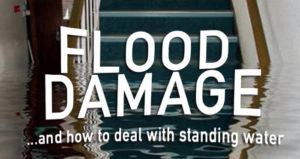Flooding can not only ruin a property and destroy personal possessions, but the water left behind can cause further damage to houses and their contents.
 There is often little you can do to prepare for flooding but there are ways to reduce the level of damage that is done to your home.
There is often little you can do to prepare for flooding but there are ways to reduce the level of damage that is done to your home.
Here are four tips to limit the level of loss a flood can cause:
1. Disconnect electrical appliances
You’ve got a far better chance of saving your prized possessions if you get them out of the way as soon as possible. Water levels may continue to rise, so ideally you should look to store belongings on higher floors.
Once you’ve moved all your electrical appliances, you can switch off the main power throughout the home. This is especially important if water rises above electrical outlets.
Make sure you inspect your home thoroughly for wall sockets, removing carpets if necessary. Your carpets can be rolled up and saved with the help of some drying and disinfectant.
2. Remove standing water
You may have already contacted a contractor to remove water from your home but if the depth is reasonably shallow, there are ways you can remove water from your home manually. Simply equip yourself with towels, a bucket and a mop to prepare for removing standing water.
The water you manage to remove can be poured down a drain but make sure that, should weather conditions be responsible for flooding, these drains are not blocked and overflowing. The most important thing to remember when working among flood waters is that electricity is extremely dangerous.
3. Disinfecting furniture
Once the drying process is complete, you need to disinfect to ensure mould cannot grow on any items that have been affected by flooding. Mould can ruin walls, floors, furniture and carpets, with damp surfaces proving to be the ideal breeding ground.
However, an item does not necessarily have to have been wet to be affected by mould as the damp atmosphere is enough to promote its growth.
In addition, harmful bacteria may have come up through the sewers or toilets. You should use gloves when disinfecting and your chosen product should be non-toxic.
4. Disposing of damaged items
It might be tempting to throw away all your damaged items but there’s a more convenient way of disposing of them.
Many water-damaged items can be recycled, which puts less pressure on landfill sites.
Article provided by property insurance claims specialist Apex Building Solutions.




